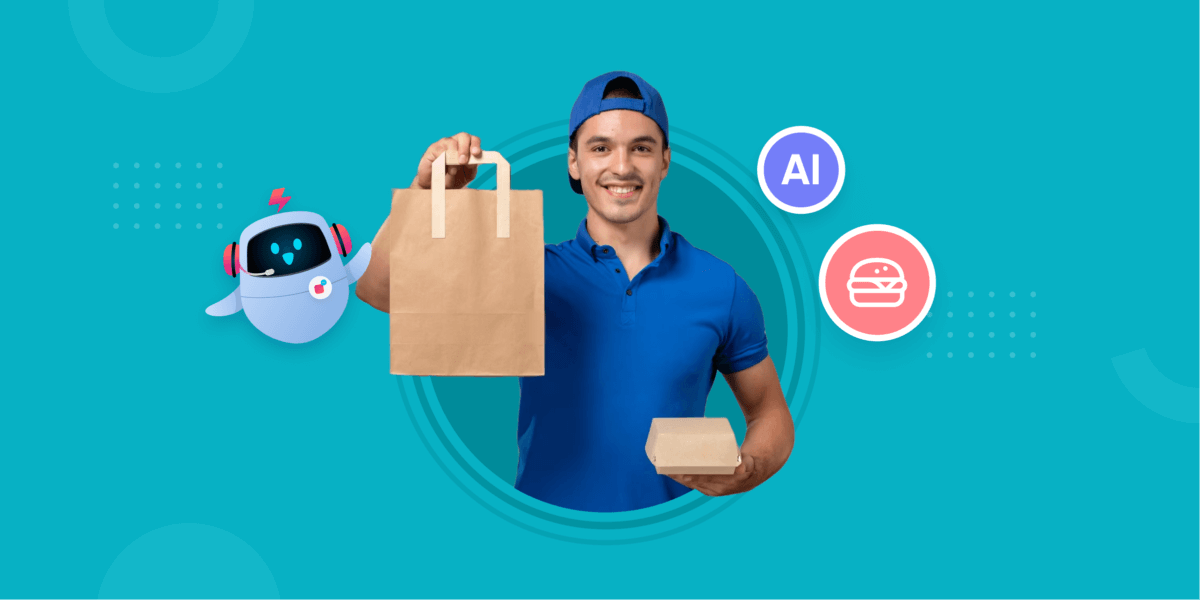From Fiction to Reality: AI’s Disruption in Food Tech

From Fiction to Reality: AI’s Disruption in Food Tech
Once upon a time in food tech, a revolution was brewing. It wasn’t sparked by a renowned chef or an acclaimed restaurant but cutting-edge technologies like Generative AI, and conversation automation. These technological marvels will disrupt the industry in ways never seen before.
This blog piece delves into the various ways in which AI technologies are poised to revolutionise the food tech industry.
We will explore the potential applications of these technologies, their impact on various aspects of the food tech ecosystem, and the benefits they bring to both businesses and consumers.
The concept of AI driven automation holds tremendous transformative potential in the field of food tech. They can revolutionize various aspects of the industry, ranging from personalized recipe recommendations to seamless dining experiences.
Let’s delve deeper into their transformative potential:
Benefits of AI in Food Tech
1. Personalised Recipe Recommendations
Generative AI algorithms powered by models like ChatGPT can analyse vast amounts of culinary data, including recipes, ingredient lists, and user preferences.
By leveraging this data, these algorithms can generate tailored recipe recommendations that cater to individual tastes, dietary restrictions, and cravings.
This level of personalisation enables users to discover new dishes that align with their preferences while still accommodating their unique dietary needs. Such personalised recipe recommendations not only enhance the user experience but also inspire culinary creativity and exploration.
2. Improved and Automated Customer Service
One of the significant impacts of Generative AI, ChatGPT, and dynamic conversation automation in food tech is the enhancement of customer service. They enable businesses to provide prompt, accurate, and personalised customer assistance.
With ChatGPT and dynamic conversation automation, restaurants and food establishments can automate customer service interactions, such as taking orders, answering frequently asked questions, and resolving common issues.
AI-powered systems can handle these tasks efficiently, reducing wait times, minimising human errors, and ensuring a seamless customer experience. Moreover, the use of Generative AI algorithms allows businesses to analyse customer feedback and sentiment data. Companies can continuously improve their products, services, and overall customer satisfaction by understanding customer preferences and sentiments.
The integration of chatbots and virtual assistants in food tech platforms also enables 24/7 customer support, eliminating the limitations of traditional operating hours. Customers can have their queries addressed and issues resolved at any time, leading to increased customer engagement and loyalty.
3. Interactive Conversations with Virtual Food Experts
ChatGPT, as a conversational AI model, enables interactive and engaging conversations with virtual food experts.
Users can ask questions, seek advice, and engage in dynamic discussions about various culinary topics. Generative AI can provide detailed explanations, share cooking tips and techniques, suggest ingredient substitutions, and offer recommendations based on user preferences.
This enables the users to have informative and personalised conversations, simulating the experience of interacting with knowledgeable food experts. It facilitates a sense of community and serves as a knowledge hub for food enthusiasts, fostering learning and collaboration within the food tech ecosystem.
4. Automation for Seamless Dining Experiences
Dynamic conversation automation, in conjunction with Generative AI and ChatGPT, streamlines routine tasks involved in dining experiences.
AI tools powered by these technologies can handle inquiries and interactions related to reservations, menu inquiries, operating hours, and special requests.
By automating these tasks, restaurants and food establishments can improve…
a) operational efficiency
b) reduce waiting times, and
c) provide a seamless customer service experience.
This automation not only enhances the efficiency of customers but also frees up human resources, allowing staff to focus on more important tasks.
5. Unlocking Innovation in Food Tech
Generative AI, ChatGPT, and dynamic conversation automation unlock new avenues for innovation in the food tech industry. These technologies enable chefs, home cooks, and food enthusiasts to push culinary boundaries, and explore innovative cooking techniques.
Moreover, they facilitate data-driven market insights, helping food tech companies identify emerging trends, predict consumer preferences, and develop new food products that resonate with evolving consumer demands.
6. Enhancing Sustainability and Accessibility
Generative AI, ChatGPT, and dynamic conversation automation can contribute to enhancing sustainability and accessibility in the food tech industry.
Such technologies can support smart meal planning, optimising ingredient usage and reducing food waste. By analysing user preferences and available ingredients, AI-powered systems can suggest recipes that efficiently utilise existing food items, minimise surplus, and repurpose leftovers.
Furthermore, they can address dietary restrictions and preferences with precision, offering suitable recipe recommendations that cater to diverse needs and ensuring inclusivity in culinary experiences.
They have the potential to make food tech more sustainable, reducing environmental impact and making culinary resources more accessible to individuals with specific dietary requirements.
Transformative Potential of AI in the Food Tech Supply Chain
AI, specifically ChatGPT and dynamic conversation automation, has a wide range of transformative potential across the food tech supply chain. It offers numerous use cases that can disrupt and improve various aspects of the industry. Let’s explore some of the most exciting applications:
1. Upstream Uses Cases for AI
In the farming sector, AI can be utilised for precision farming. This includes applications such as crop monitoring, where AI analyses satellite imagery and sensor data to monitor crop health and predict yields.
AI can also help farmers with sales predictions, determining the optimal time to sell their output based on market trends.
Additionally, AI can assist with input management, optimising the use of water and fertilisers for crops. Livestock monitoring is another area where AI can be employed to track the health and behaviour of animals, aiding in disease prevention.
Furthermore, farm automation using AI-powered robots can help with tasks like harvesting crops and weed control.
2. Midstream Uses Cases for AI
In the food science and transformation stage, AI can be applied to recipe optimisation.
By gathering consumer preference data, AI algorithms can create new recipes and meal planners. This has promising implications for an industry where balancing cost, processing, and taste is complex.
AI has also found applications in the alternative proteins space. It can identify interesting properties in plants that can be used for cleaner-label alternatives.
Additionally, AI is used in precision fermentation, accelerating the process of recreating desired proteins from bacteria. Managing bioreactors for cellular agriculture is another area where AI can improve efficiency and scalability.
3. Downstream Uses Cases for AI
In the downstream phase, AI can be utilised for quality control and food safety checks. It can also be used to optimise supply chains, and reducing food waste.
AI can help adjust prices in real-time when fresh products are at risk of being wasted. It can also improve data sharing between suppliers and retailers, enhancing transparency and efficiency.
Furthermore, AI can assist in creating personalised nutrition plans based on consumers’ health and dietary preferences, improving adherence to recommendations. Conversational AI tools, such as ChatGPT, can significantly enhance the consumer experience by providing relevant information and personalised guidance.
Suggested Reading: How Conversational AI Plays a Key Role in Foodservice Industry
Unlock the Full Potential of AI with Verloop.io!
The impact of AI is revolutionary, fundamentally reshaping how we explore food. The food tech industry can foster creativity, inclusivity, and sustainability through its remarkable capabilities, promoting a blend of unique flavours and diverse culinary practices. However, its realisation may take time as it suggests changes throughout the supply chain.
Regardless of this, it also presents significant opportunities for established players to distinguish themselves in the market.
In the dynamic world of food tech, staying ahead of the curve is crucial. That’s where Verloop.io swoops in and helps you revolutionise and scale your business.
With Conversational and Generative AI at its core, Verloop.io takes automation to the next level and helps you gain a competitive edge in the food tech industry. Schedule a demo with us today and witness firsthand how you can revolutionise your business and take your culinary experiences to new heights.






